Datebook: Alison Saar’s literary sculptures, art of ancient Egypt and beyond, fresh interpretations on landscape
A historic American novel inspires sculpture by Alison Saar, while a show at the Getty Museum explores culture exchange in the ancient Mediterranean. Here are five exhibitions and events landing in L.A. in the coming week:
Alison Saar, “Topsy Turvy,” at L.A. Louver. This show of new work by the L.A.-based artist takes the character of Topsy, from Harriet Beecher Stowe’s “Uncle Tom’s Cabin” as a point of inspiration. In sculpture and painting, she transforms the young slave girl into a symbol of defiance and, in the process, weaves in elements of Greek myth into Topsy’s story. This looks like a must-see. On May 1 at 7 p.m., the artist will lead a listening party of “angry songs.” RSVP is required (310-822-4955 or rsvp@lalouver.com). Through May 12. 45 N. Venice Blvd., Venice, lalouver.com.
“Beyond the Nile: Egypt and the Classical World,” at the Getty Museum. A new exhibition at the Getty explores the cultural connections between Greece, Rome and Egypt through more than 200 rare objects — many on view in the U.S. for the first time. The show spans more than 2,000 years, from the Bronze Age to the late Roman Empire and includes stone vessels, pottery, sculpture, portraits and religious imagery. It also includes a more than 15-foot granite obelisk from A.D. 88-89 inscribed to the goddess Isis and the emperor Domitian, on loan from the Museo del Sannio in Italy. Through Sept. 9. 1200 Getty Center Dr., Brentwood, Los Angeles, getty.edu.
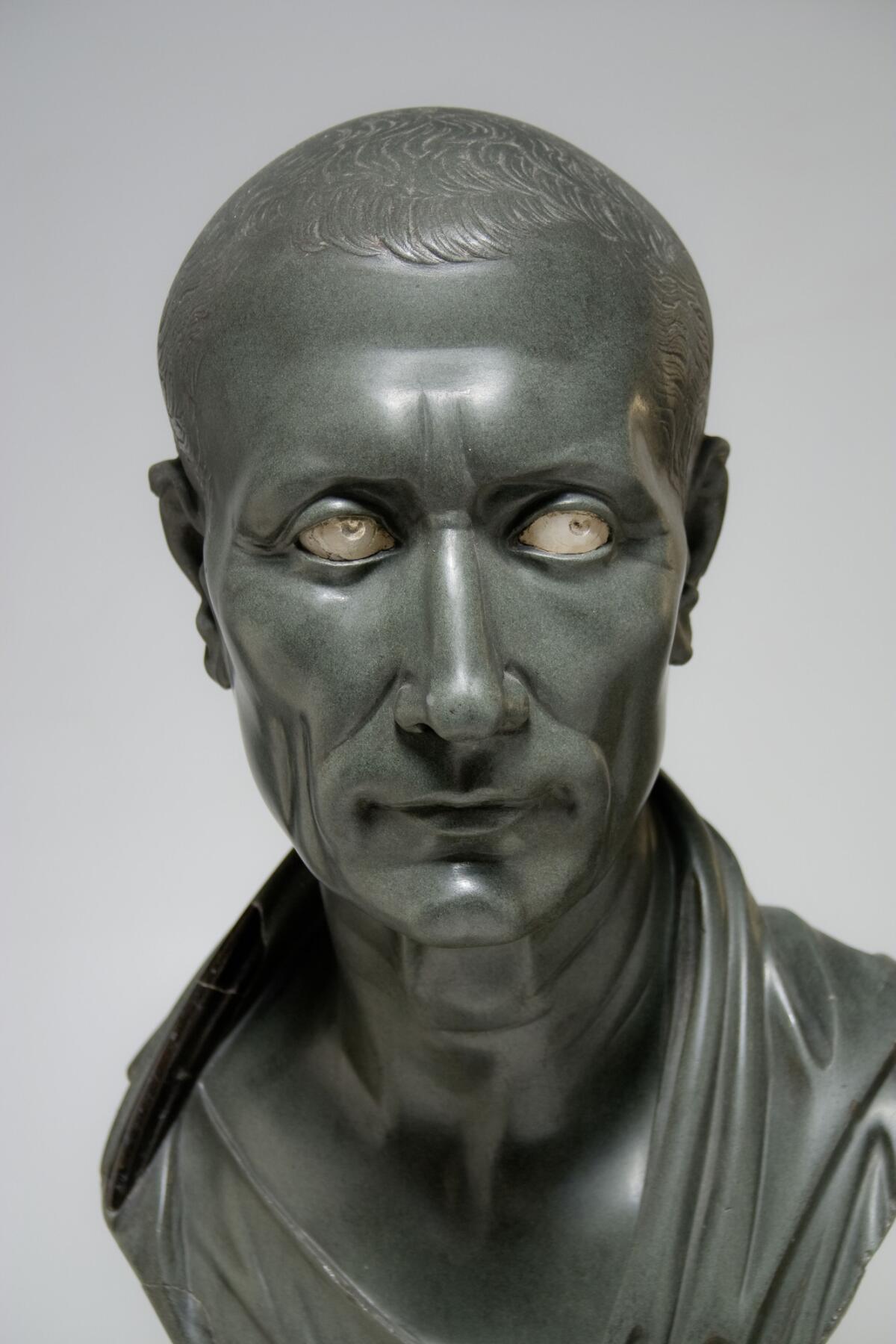
“Force of Nature,” at Steve Turner. A group show featuring six international artists from Los Angeles presents paintings and video that employ landscape to explore current events such as immigration, environment and technology, among other themes. This includes artists from Los Angeles (Eddie Rodolfo Aparicio, Nick Farhi and John Knuth), Paris (Émilie Broute & Maxime Marion), Cologne (Lukas Marxt) and New York (Glen Baldridge). Opens Saturday and runs through May 12. 6830 Santa Monica Blvd., Hollywood, steveturner.la.
Momus Book Launch, at Night Gallery. The esteemed art website will be celebrating the publication of its first print volume, featuring essays by Los Angeles art scribes Catherine Wagley and Andrew Berardini, among many others. Things will kick off with a celebratory drink and a short reading. If you can’t make it, you can always find the book from the Momus website. Saturday 2 p.m. to 4 p.m. 2276 E. 16th St., downtown Los Angeles, facebook.com/momusart.
The Wooster Group, “A Pink Chair (In Place of a Fake Antique),” at REDCAT. A new work by the esteemed New York theater group engages the life and work of avant-garde Polish painter and playwright Tadeusz Kantor. Specifically, it focuses on the play “I Shall Never Return,” with its echoes of World War II and the ways in which violence can leave individuals unmoored. Opens April 5 and runs through April 15. 631 W. 2nd St., downtown Los Angeles, redcat.org.
LAST CHANCE
“Between Post and Pre: Hilbertraum at Durden and Ray,” at Durden and Ray. A new group show featuring work by more than a dozen artists looks at the act of art making in a world in flux — with works that operate like individual “reality islands.” Through Saturday. 1923 S. Santa Fe Ave., downtown Los Angeles, durdenandray.com.
“Vija Celmins,” at Matthew Marks Gallery. This show gathers more than 20 works produced over the last four years by the artist. It is the first exhibition of Celmins new work in L.A. in more than 40 years. This includes a large painting of a night sky in reverse — featuring dark stars on a light sky — and a close-up painting of cracks on a plate that becomes a pattern of lines and color. Expect work that invites introspection. Through Saturday. 1062 N. Orange Grove Ave., West Hollywood, matthewmarks.com.
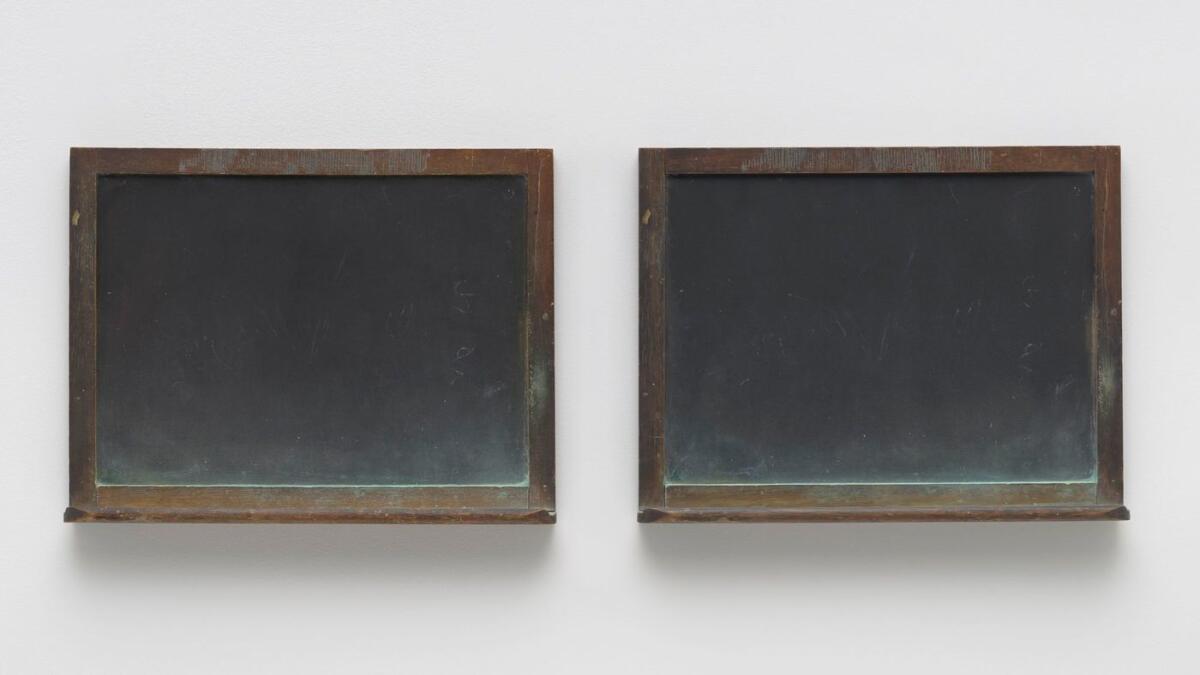
Sheridan Lowrey, “Bulky Item/Curb Alert,” at Cornelius Projects. The artist records the myriad castoffs that appear on San Pedro streets — bit of private lives that end up in public space. Through Saturday. 1417 S. Pacific Ave., San Pedro, corneliusprojects.com.
Herakut, “Herakut’s Rental Asylum,” at Corey Helford Gallery. The street art duo known as Herakut — Jasmin Siddiqui and Falk Lehmann — are known for the bold figurative murals they have placed in cities all over the world. This show gathers their work on canvas, combining photo-realist tendencies and the drips of street painting. Through Saturday. 571 S. Anderson St., Boyle Heights, Los Angeles, coreyhelfordgallery.com.
“By the Lights of Their Eyes,” at Shulamit Nazarian. A group exhibition featuring the works of six artists plays on tropes of fantasy, mysticism and science fiction. This includes the work of London photographer Juno Calypso, who stages fictional scenarios in a setting reminiscent of a honeymoon suite, and San Francisco-based Katie Dorame, who creates paintings on movie stills that toy with American Indian roles in the history of film. Through Saturday. 616 N. La Brea Ave., Hancock Park, Los Angeles, shulamitnazarian.com.
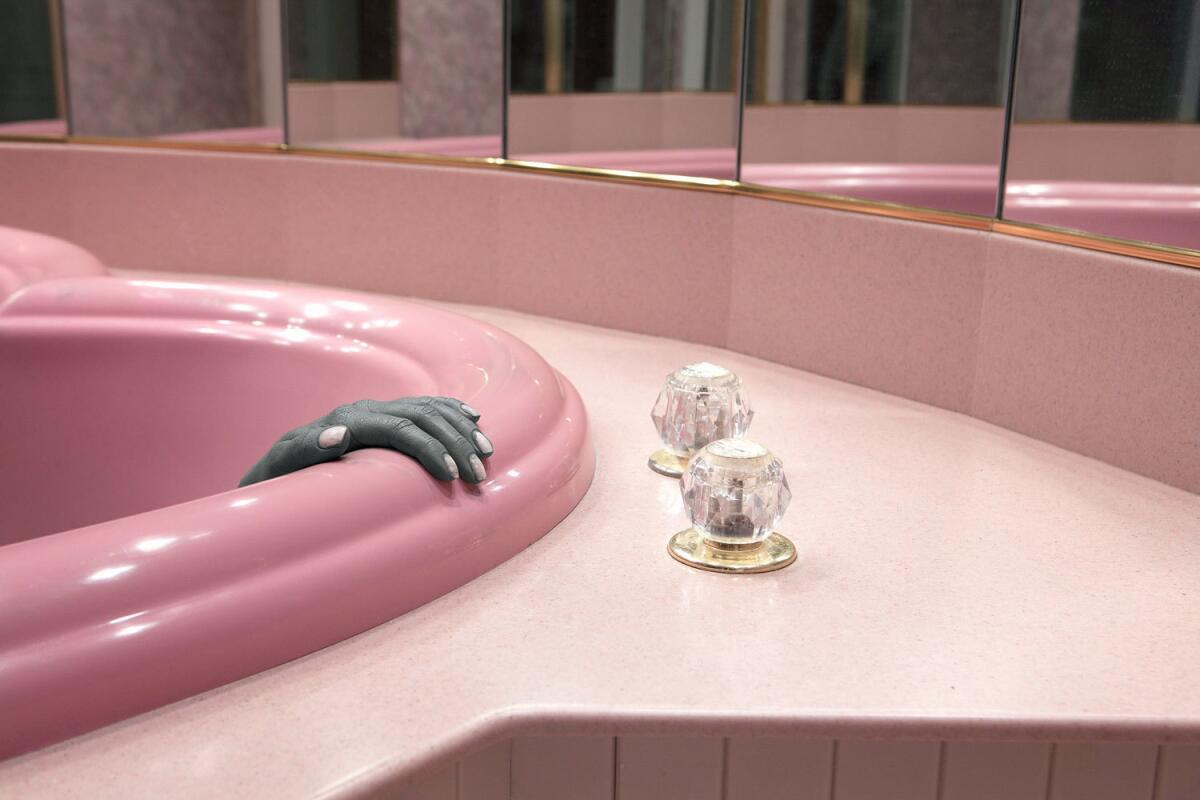
Mondongo, “What are we gonna say after HELLO?” at Track 16 Gallery. The Argentine collective, which recently had work on view in two Pacific Standard Time exhibitions, is known for creating wild vitrines and dioramas out of carefully assembled bits of detritus or Plasticine. These sculptural pieces — part painting, part three-dimensional object — often evoke dystopic fairy tales, with an acerbic eye toward social, political and economic issues. Through Saturday. 1206 Maple Ave., No. 1005, downtown Los Angeles, track16.com.
“Found in Translation: Design in California and Mexico,” at the Los Angeles County Museum of Art. A groundbreaking exhibition looks at the points of connection in design — architectural, fashion, graphic and other — between California and Mexico from 1915 to 1985. It’s a thorough examination of how designers in the two places combined local materials with an interest in pre-Columbian and colonial design, as well as folk and craft traditions, to create singular approaches to Modernism that also overlapped in countless ways. The exhibition includes a diverse range of objects, including dresses, political posters, architectural drawings, furnishings and a show-stopping late 19th century piano carved in a pre-Columbian style. Wowza! Through April 1. 5905 Wilshire Blvd., mid-Wilshire, Los Angeles, lacma.org.
ONGOING
Pontus Willfors, “Shop,” at Denk. The sculptor is known for his creative takes on mundane objects: cars and shopping carts crafted from wood, furnishings rendered in surreal ways, wood sculptures that are sculptures but also bits of tree. At Denk, he will present a series of new works. Through April 7. 749 E. Temple St., downtown Los Angeles, denkgallery.com.
“Patrick Martinez: America Is for Dreamers,” at the Vincent Price Art Museum. This is the artist’s first solo museum exhibition in Los Angeles, a figure whose work examines the city’s landscape (such as stucco walls, commercial neon, street signage) as much as the social forces that shape it (inequity and police violence). The show’s title toys with notions of the American dream, as well as the uncertain status of recipients of Deferred Action for Childhood Arrivals (known as DACA), the federal program that allows immigrants brought to the U.S. as children to remain in the country. Through April 7. East Los Angeles College, 1301 Cesar Chavez Ave., Monterey Park, vincentpriceartmuseum.org.
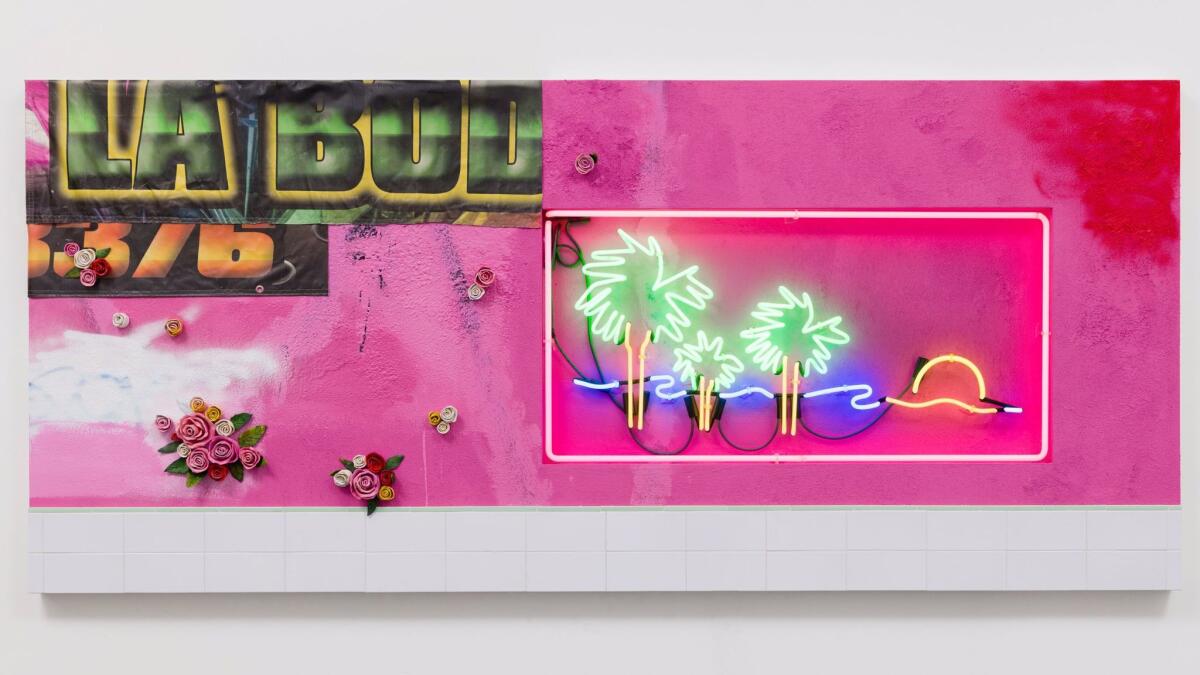
Skip Arnold, “Truffle Hunt,” at the Institute of Contemporary Art Los Angeles. A video installation by Los Angeles-based Skip Arnold is centered on a film that followed Arnold, along with artists Jason Rhoades and Hans Weigand, on a journey to Europe in search of truffles. The show includes maps and other ephemera from their journey — as well as truffles that were smuggled back to L.A. by the artists. Through April 8. 1717 E. 7th St., downtown Los Angeles, theicala.org.
“Outcasts: Prejudice and Persecution in the Medieval World,” at the Getty Museum. An exhibition of medieval manuscripts looks at how the illustrations featured on their pages often revealed a range of era prejudices: against women, Jews, Muslims, blacks, homosexuals, the poor and the ill, who were often depicted in menacing or cartoonish ways. Also included are examples in which images were censored in the name of politics or morality. This one looks fascinating. Through April 8. 1200 Getty Center Drive, Brentwood, Los Angeles, getty.edu.
“Liquid Love,” at Gas. Parked outside of the Pit gallery in Glendale is this ambulatory gallery space featuring a group show that explores desire, love and affection — and the ways in which technology intersects with these needs. Artists in the show include Cara Benedetto, Kathy Cho and Angelo Washko. Through April 14. 918 Ruberta Ave., Glendale, gas.gallery.
“Every Ongoing Day,” at Arena 1 Gallery. Every day we brush our teeth and put on our shoes. Every day, some people paint or draw or photograph. This exhibition gathers artists who make work daily as part of a long-running ritual practice. This includes pieces by Margot Guralnick, Annetta Kapon, Jody Zellen and Laura Cooper and Nick Taggart. Through April 14. 3026 Airport Ave., Santa Monica, arena1gallery.com.
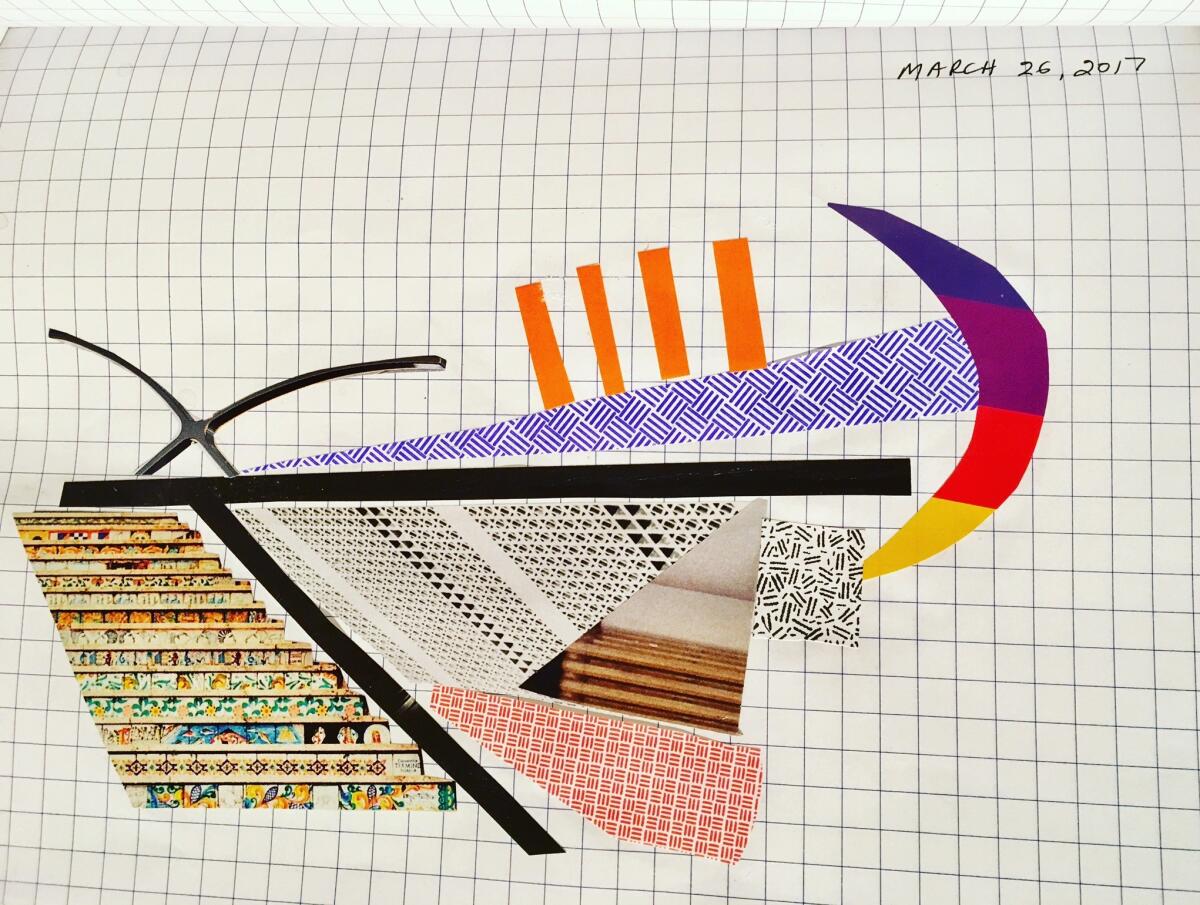
Senga Nengudi, “Improvisational Gestures,” at the Fisher Museum of Art. An artist known as much for installation (wild webs of pantyhose that seem to strangle and pull) as she is for dance-inspired performances, Nengudi is the subject of a solo show at the museum that provides a comprehensive overview of her work — including formative years in Los Angeles. Through April 14. USC, 823 Exposition Blvd., Exposition Park, Los Angeles, fisher.usc.edu.
Yvette Gellis and Ty Pownall, “Liminal Spaces,” at Jason Vass. A two-person show features Gellis’ large mixed-media paintings that feature elements of the built environment, as well as sculptures by Pownall that are inspired by architecture and space. Through April 14. 1452 E. 6th St., downtown Los Angeles, jasonvass.com.
Robert Irwin, “Site Determined,” at the University Art Museum. In 1975, Irwin installed a sculptural piece called “Window Wall” into a building on the Cal State Long Beach campus. The work, a frame of sorts, was embedded into the school’s architecture, and served as a space from which to contemplate the environment of the campus. That piece was a turning point in his career — and serves as a departure point for this exhibition, which examines four decades of the artist’s outdoor projects. Through April 15. Cal State Long Beach, 1250 Bellflower Blvd., Long Beach, csulb.edu/university-art-museum.
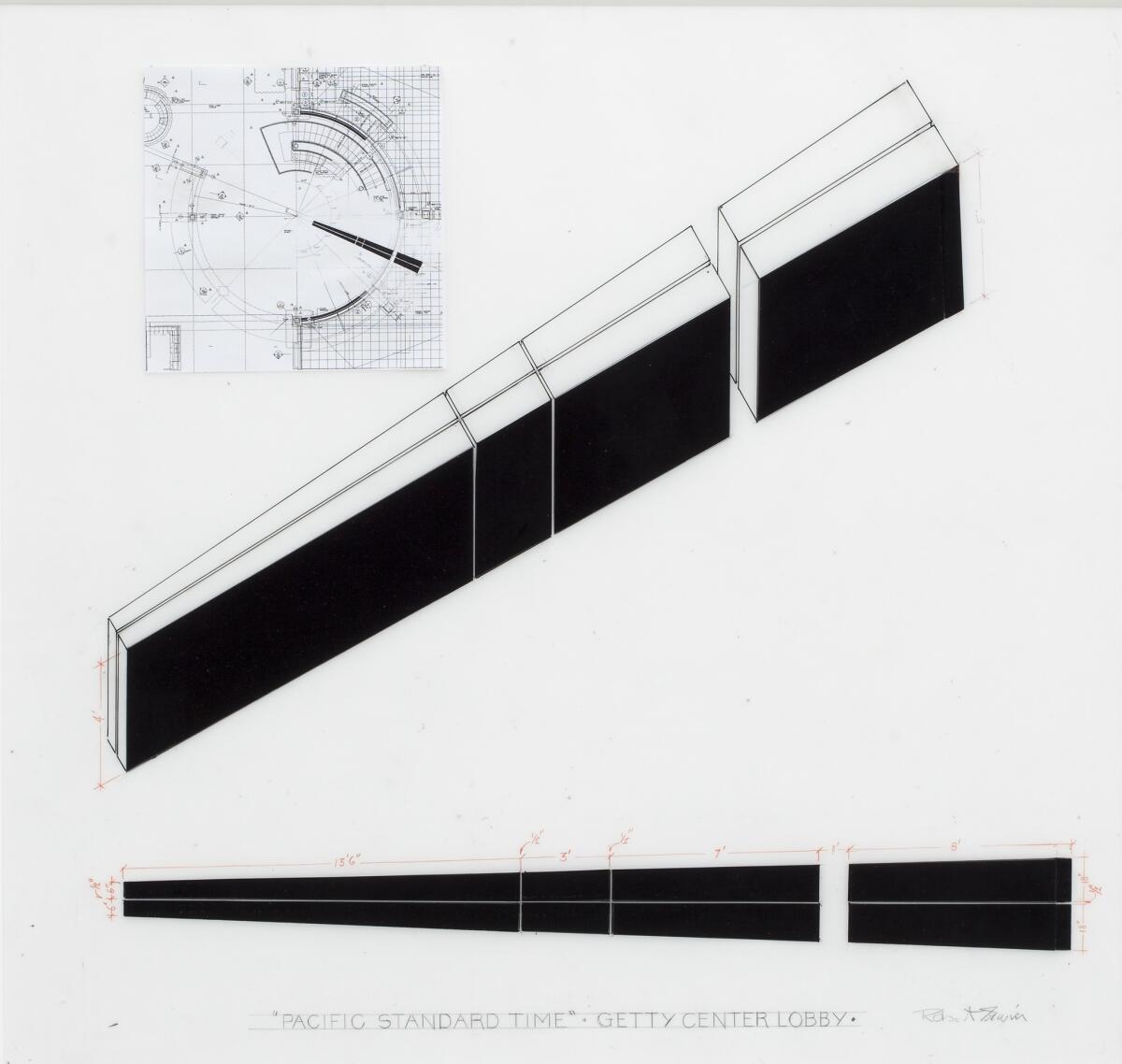
Alyson Souza, “Life Among the Polygons,” at Coagula Curatorial. Souza makes paintings that also draw from traditions of assemblage and collage — putting together curious combinations that seem to meld the mundane and the fantastical, the organic with the mechanical. Through April 15. 974 Chung King Road, Chinatown, Los Angeles, coagulacuratorial.com.
“Axé Bahia: The Power of Art in an Afro-Brazilian Metropolis,” at the Fowler Museum. Brazilian art has been well-represented throughout the Pacific Standard Time exhibitions around the region. This show looks specifically at what has been happening artistically since the 1940s in Bahia, the city that represents the heart of Afro-Brazilian culture. This features works by key Modernists, including Mário Cravo Neto and Rubem Valentim, as well as contemporary figures such as as Caetano Dias and Ayrson Heráclito — all represented in more than 100 works of sculpture, painting, photography, video and installation. Through April 15. UCLA, 308 Charles E. Young Drive North, Westwood, Los Angeles, fowler.ucla.edu.
Norm Clasen, “Titled (Cowboy),” at M+B Photo. In the 1980s, conceptual artist Richard Prince became known for re-photographing images of Marlboro ads of cowboys at work. Clasen was the photographer who shot many of those original images. M+B surveys the photographer’s images of the American West. In a stab at appropriationist history, a portion of the profits will be donated to the APA (American Photographic Artists) to help support copyright defense. Through April 21. 1050 N. Cahuenga Blvd., Hollywood, mbphoto.com.
Nicole Eisenman, “Dark Light,” at Susanne Vielmetter Los Angeles Projects. This exhibition is the U.S. debut of a series of paintings that the New York artist showed at the Secession in Vienna in 2017. It also includes new works made especially for the Los Angeles show. The artist is known for creating slightly surreal paintings that deftly combine both the comical and the abject. Her works in this show, which includes sculptural pieces, will come together to form a stage set called “Monument to a Politician.” On opening night, the artist and L.A.-based artist Math Bass will conduct a reading of Bernadette Mayer’s poem “To a Politician” from that very stage. Through April 21. 6006 Washington Blvd., Culver City, vielmetter.com.
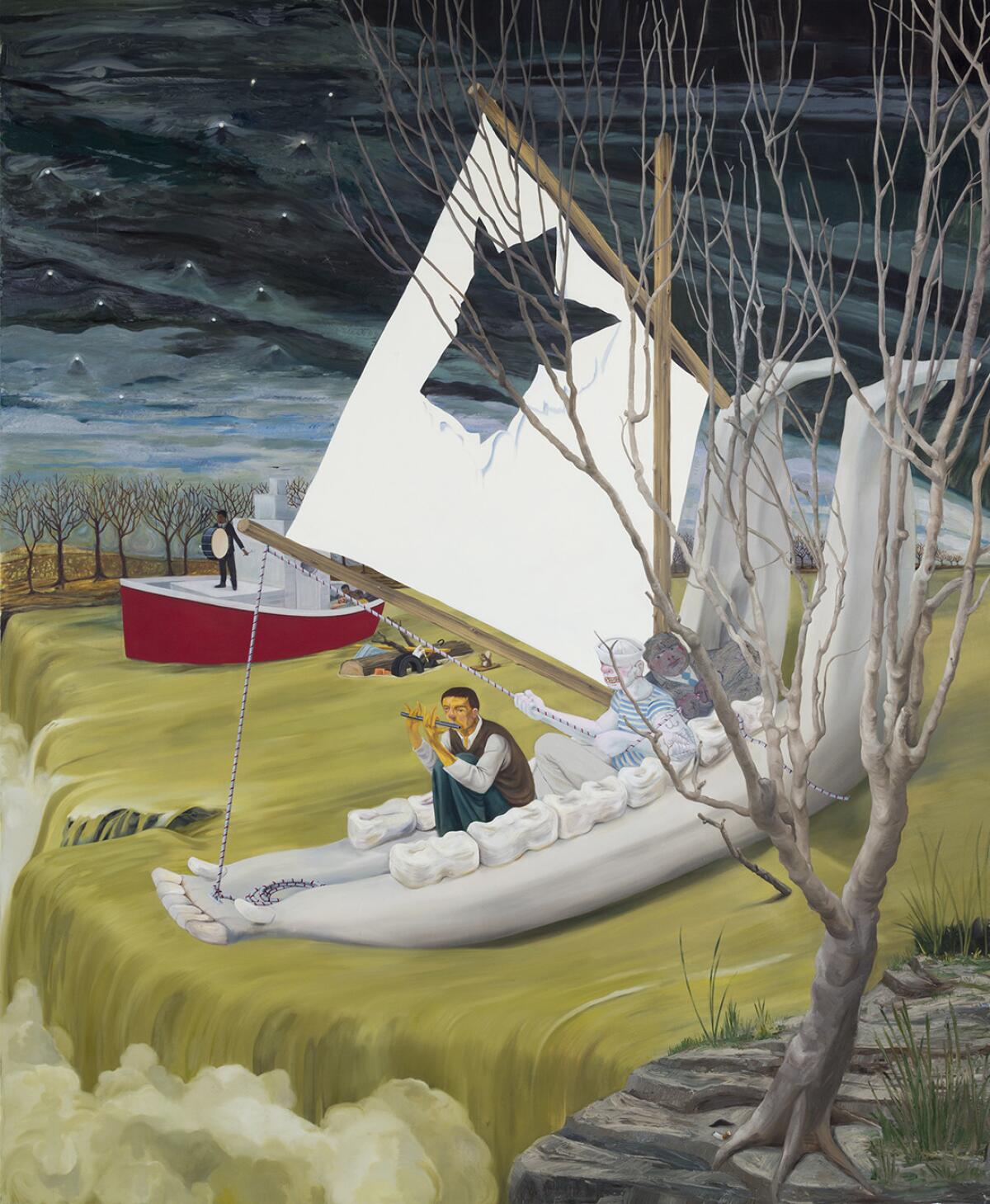
Rachel Mason, “Star Death and the Pain Body,” at Charlie James Gallery. The performance artist behind Future Clown (whom I followed around on Inauguration Day) has a new immersive video environment at Charlie James that is part of an ongoing project that connects aspects of cosmology (the cycles of the stars) to human trauma. This particular segment looks at literal and metaphorical aspects of a star’s turbulent death. Through April 21. 969 Chung King Road, Chinatown, Los Angeles, cjamesgallery.com.
Christiane Feser, “New Work,” and Christopher Russell, “The Explorers,” at Von Lintel Gallery. On view are two artists who experiment with the nature and form of photography. Russell, who is from Los Angeles, scratches drawings into the surface of his photographs — creating layered pieces that toy with image and texture. Feser constructs elaborate geometric paper models that she then photographs, creating images that offer plays on color, form and light. Both artists are featured in the Getty Center exhibition “Cut! Paper Play in Contemporary Photography.” Through April 21. 2685 S. La Cienega Blvd., Culver City, vonlintel.com.
Harald Szeeman, “Grandfather: A Pioneer Like Us,” at the Institute of Contemporary Art Los Angeles. In the 1970s, celebrated curator Harald Szeeman organized the objects collected and created by his grandfather — a noted hairdresser — into an installation that he staged in his home. The show at the ICA LA features a recreation of Szeeman’s show and materials from the Getty Research Institute, which holds the curator’s archive. Through April 22. 1717 E. 7th St., downtown Los Angeles, theicala.org.
Petra Cortright, “CAM WORLD,” at UTA Artist Space. The gallery has put together a large-scale survey of the L.A.-based artist’s video work that draws from the culture of surveillance and the internet. This includes pieces that dwell on the artist’s online presence and the ways in which the female body is rendered online. Through April 27. 670 S. Anderson St., Boyle Heights, Los Angeles, utaartistspace.com.
Iris Yirei Hu, “Survival Guide: inheritance,” at the Women’s Center for Creative Work. An immersive installation is centered on the idea of weaving — of the apprenticeships the artist has had with weavers in Arizona and Oaxaca, Mexico — and the collaborative piece she crafted with eight invited artists. Titled “Magic Carpet,” this latter work occupies much of the floor and is made from a diverse array of materials. Through April 27. 2425 Glover Pl., Elysian Valley, Los Angeles, womensceterforcreativework.com.
Veronika Kellndorfer and Antonio Ballester Moreno, at Christopher Grimes Gallery. One is a photographer, the other a painter. But their work each explores the ideals of Modernism. Kellndorfer, who lives in Berlin, photographs renowned Modernist architectural spaces, often playing with the ideas of the transparent surface, whether it’s by depicting glassy architecture or, quite literally, by presenting her work on glass. Ballester, in the meantime, studies stripped-down line and form in paintings that echo the work of figures such as Joan Miró and Josef Albers. Through April 28. 916 Colorado Ave., Santa Monica, cgrimes.com.
Katherine Sherwood, “The Interior of the Yelling Clinic,” at Walter Maciel Gallery. In her first show at the gallery, Sherwood is featuring works from her “Venuses” series — paintings that take the traditional female nude and alter her body in some visceral way. Her figures are depicted with an amputated limb, a leg brace or an artificial hand; for heads, they sport large scans of the artist’s brain. (Sherwood suffered a cerebral hemorrhage 20 years ago and had to switch painting hands.) These are figures that beguile and confront. Through April 28. 2461 S. La Cienega Blvd., Culver City, waltermacielgallery.com.

“Cold War Spaces,” “The Russians” and “Vessel of Change” at the Wende Museum. The museum, an underrated Los Angeles gem preserving the art and history of the Cold War, is celebrating a move to new digs at the National Guard Armory in Culver City. The grand reopening is marked by the debut of three new exhibitions: “Cold War Spaces” looks at the design of public and private environments, borders and the objects sent into outer space by the U.S. and the Soviet Union. “The Russians” is based on a 1970s photo project by Nathaniel Farb that documented a diverse array of ordinary Russians, while “Vessel of Change” is a playful video piece by Bill Ferehawk and David Hartwell that reinterprets the historic Malta Summit between George H.W. Bush and Mikhail Gorbachev in 1989. Through April 29. 10808 Culver Blvd., Culver City, wendemuseum.org.
“Hammer Projects: Sam Falls” at the Hammer Museum. For the Hammer’s latest lobby project, the L.A.-based artist traveled to all 19 national forests in California. In these journeys, he gathered samples of the state’s vegetation, including Ponderosa pine trees and California buckwheat. He then dusted the samples with pigment, employing them as stencils of sorts, to create silhouettes of important state flora. Through April 29. 10899 Wilshire Blvd., Westwood, Los Angeles, hammer.ucla.edu.
John Ford, Samuel Fuller, George Stevens, “Filming the Camps: From Hollywood to Nuremberg,” at the Los Angeles Museum of the Holocaust. Organized by the Mémorial de la Shoah in Paris, this exhibition looks at the vital work done by three key American filmmakers during World War II. Ford, Fuller and Stevens, in the employ of the U.S. Armed Forces and the Secret Services, filmed key aspects of the war — including the liberation of the Nazi concentration camps. The show includes film footage, personal letters, important ephemera and other rare objects and reflects on the way in which playing witness to Nazi atrocities shaped the worldview of these important directors. There could not be a more timely moment for this exhibition. Through April 30. 100 S. Grove Drive, Fairfax, Los Angeles, lamoth.org.
Kim Schoenstadt, “Context v. Perspective,” at Chimento Contemporary. For this series of works, Schoenstadt takes well-known buildings that evoke social unrest — the FBI headquarters in Washington, various Soviet structures — and uses them to explore the idea of context (the broader view) versus individual perspective (a much narrower vista). These are works whose very architecture spills out of the frame. Through May 5. 622 S. Anderson St., #105, Boyle Heights, Los Angeles, chimentocontemporary.net.
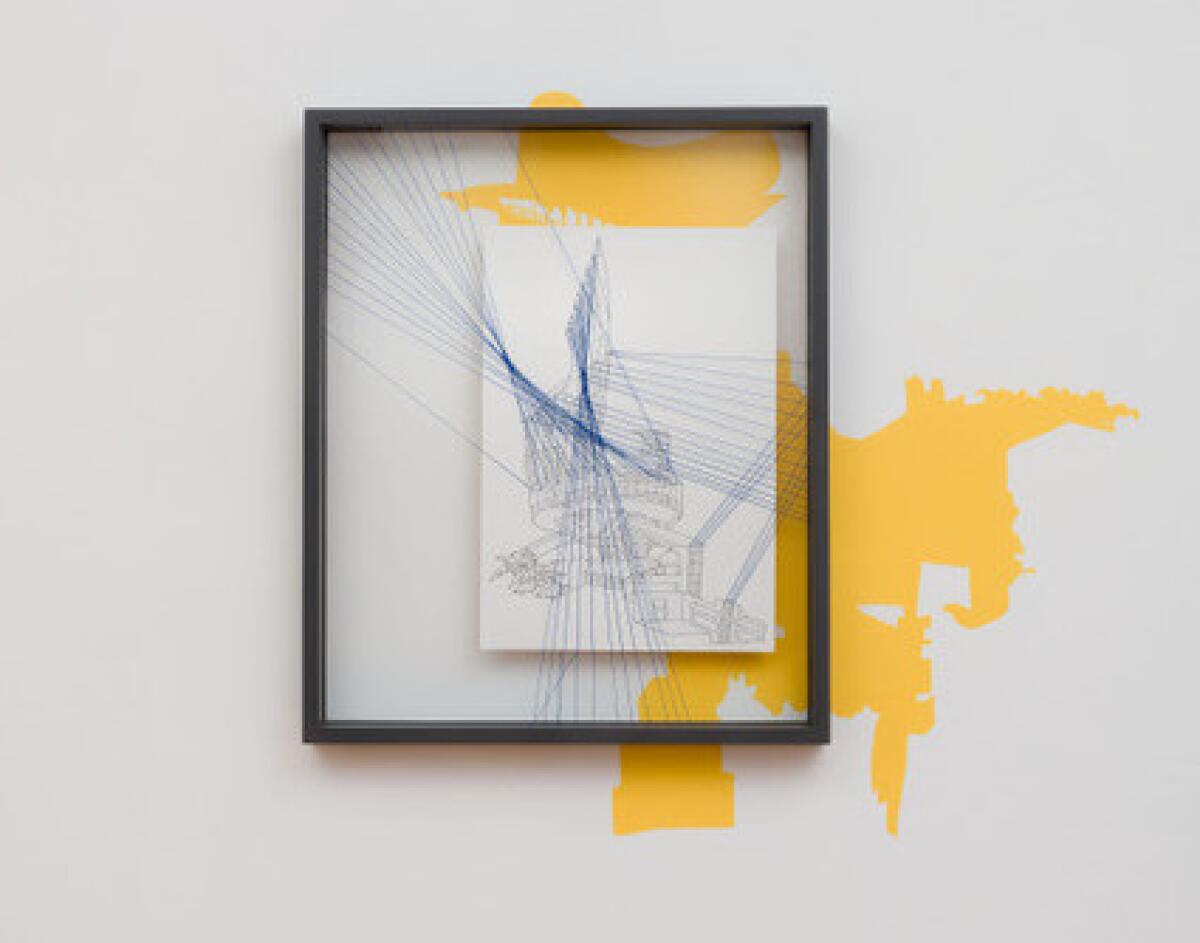
“Harald Szeemann: Museum of Obsessions,” at the Getty Research Institute. This exhibition explores the life, work and obsessions of the esteemed Swiss curator who helped redefine the profession. The show examines his early exhibitions and the ways in which he collaborated with avant-garde artists, the ways in which he turned curation into a global job, as well as his personal collections and obsessions. Through May 6. 1200 Getty Center Drive, Brentwood, getty.edu.
“Stories of Almost Everyone,” at the Hammer Museum. In the age of hyper-conceptual art, the story about the art often resides less in the object than in the stories that are told about it: the curator talks and wall text descriptions. This exhibition examines this very phenomenon — the curious oral history often generated by conceptual work and how those histories are passed on. Should be seriously brainy. Through May 6. 10899 Wilshire Blvd., Westwood, Los Angeles, hammer.ucla.edu.
“Melting Point: Movements in Contemporary Clay,” at the Craft & Folk Art Museum. This is the museum’s first biennial devoted to clay, featuring work by almost two dozen artists who are working with the material in innovative and unusual ways. Through May 6. 5814 Wilshire Blvd., mid-Wilshire, cafam.org.
“Robert Polidori: 20 Photographs of the Getty Museum, 1997” at the Getty Museum. The Getty has turned 20 (it can almost drink!), and to mark the occasion the museum is showing a portfolio of works created by Polidori prior to the museum’s opening in ’97. The photos, on view for the first time, caught the galleries in transition: art wrapped in crates, sculptures off pedestals, bits of packing material in decorative rooms. Through May 6. 1200 Getty Center Drive, Brentwood, Los Angeles, getty.edu.
Karen Margolis, “Garden of Mutei,” at Garis & Hahn. In her first solo exhibition at the gallery, the Brooklyn-based artist is showing large, intricate paper works that serve as maps of thought and synapse. She achieves her geometric patterns by cutting, paintings and collaging, with thread, fragments of maps and other elements. Through May 12. 1820 Industrial St., downtown Los Angeles, garisandhahn.com.
Adrián Villar Rojas, “The Theater of Disappearance,” at the Museum of Contemporary Art. The Argentine-born artist, known for installations that transform spaces — and often play on themes of the apocalyptic — is taking over MOCA’s Little Tokyo space with an installation that employs the architecture and technologies of Hollywood special effects to create an environment that responds to a “post-human world dominated by technology.” Through May 13. Geffen Contemporary, 152 N. Central Ave., downtown Los Angeles, moca.org.
“Muse: Mickalene Thomas,” and “tête-à-tête,” at Pomona College Museum of Art. This show explores two aspects of Thomas’ work: the muses that have inspired her work and the artists with whom she finds kinship. The first part gathers the artist’s photography of herself, her mother, her friends and lovers — images that inspire and serve as the basis of her work. The latter part features an installation curated by Thomas that features work by artists she finds inspiring, including Deana Lawson, Zanele Muholi and LaToya Ruby Frazier. Through May 13. 330 N. College Ave., Claremont, pomona.edu/museum.
Dora De Larios, “Other Worlds,” at the Main Museum. Over a long-running career, the Los Angeles-born ceramic artist created work that fused the modern with the Mexican and the Japanese. Now the downtown museum is inaugurating a new gallery space with a survey of the late artist’s work — De Larios died in January — bringing together whimsical sculpture, graceful dishware and the elegant plates she crafted especially for a White House lunch. Through May 13. 114 W. 4th St., downtown Los Angeles, themainmuseum.org.
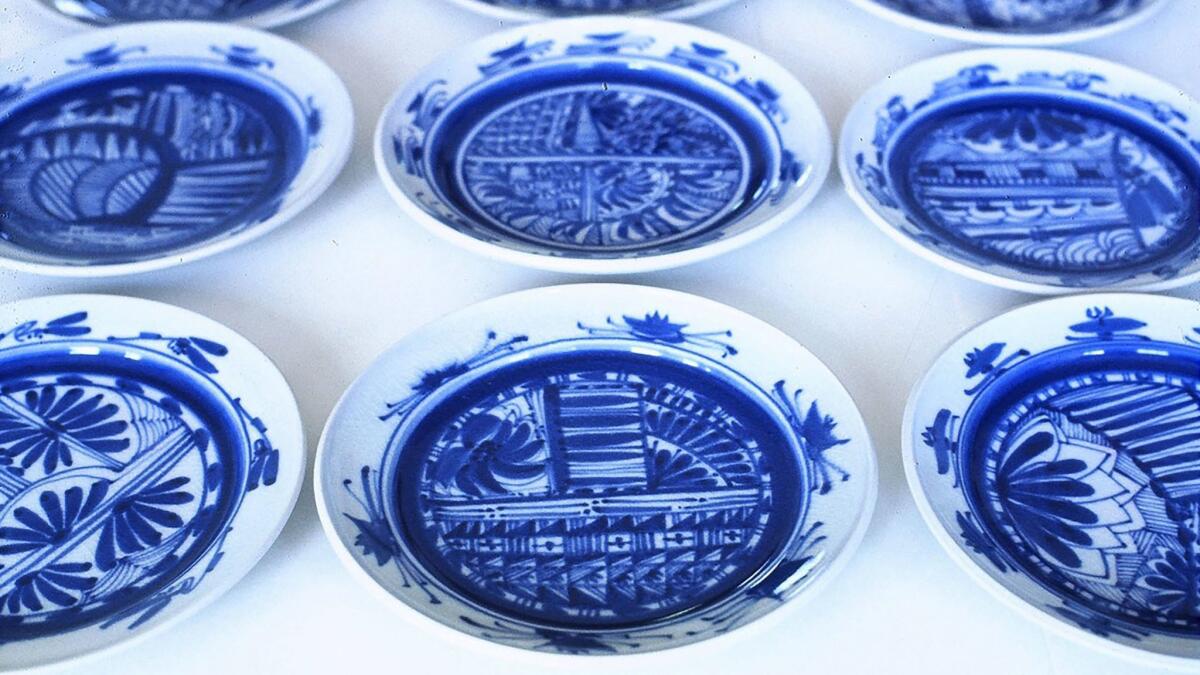
Rigo 23, “Ripples Become Waves,” at the Main Museum. This show by the L.A.-based artist Rigo 23 highlights the case of Leonard Peltier, a member of the American Indian Movement who received a life sentence in connection with the shooting deaths of two FBI agents in 1975. On view will be a sculpture of Peltier that the artist made for American University’s campus in 2017, a work that was subsequently (and controversially) removed. Through May 13. 114 W. 4th St., downtown Los Angeles, themainmuseum.org.
“Unspeakable: Atlas, Kruger, Walker,” at the Hammer Museum. The museum has installed videos by three artists — Charles Atlas, Barbara Kruger and Kara Walker — known for the ways in which they wield art as social critique. This includes works that ruminate on the nature of life, generosity, the body and violence. Through May 13. 10899 Wilshire Blvd., Westwood, Los Angeles, hammer.ucla.edu.
Jasper Johns, “ ‘Something Resembling Truth,’ ” at the Broad museum. An exhibition created in collaboration with the Royal Academy in London will feature more than 120 paintings, sculptures, prints and drawings by the celebrated 20th century artist associated with the early days of the Pop movement. The show traces his six-decade career through a series of themed installations that examine the stages of his career, as well as the innovative ways in which he employed materials such as encaustic, collage and other media. The show includes many works that have never been seen before in Los Angeles — a real treat. Get those tickets! Through May 13. 221 S. Grand Ave., downtown Los Angeles, thebroad.org.
Chris Kraus, “In Order to Pass,” at Chateau Shatto. The celebrated author of “I Love Dick” was a filmmaker before she became a writer. This exhibition focuses on that work — namely, the nine films she made in the 1980s and ’90s, experimental works that dwell on feminism, historical themes and relationships. Through May 19. 1206 S. Maple Ave., Ste. 1030, downtown Los Angeles, chateaushatto.com.
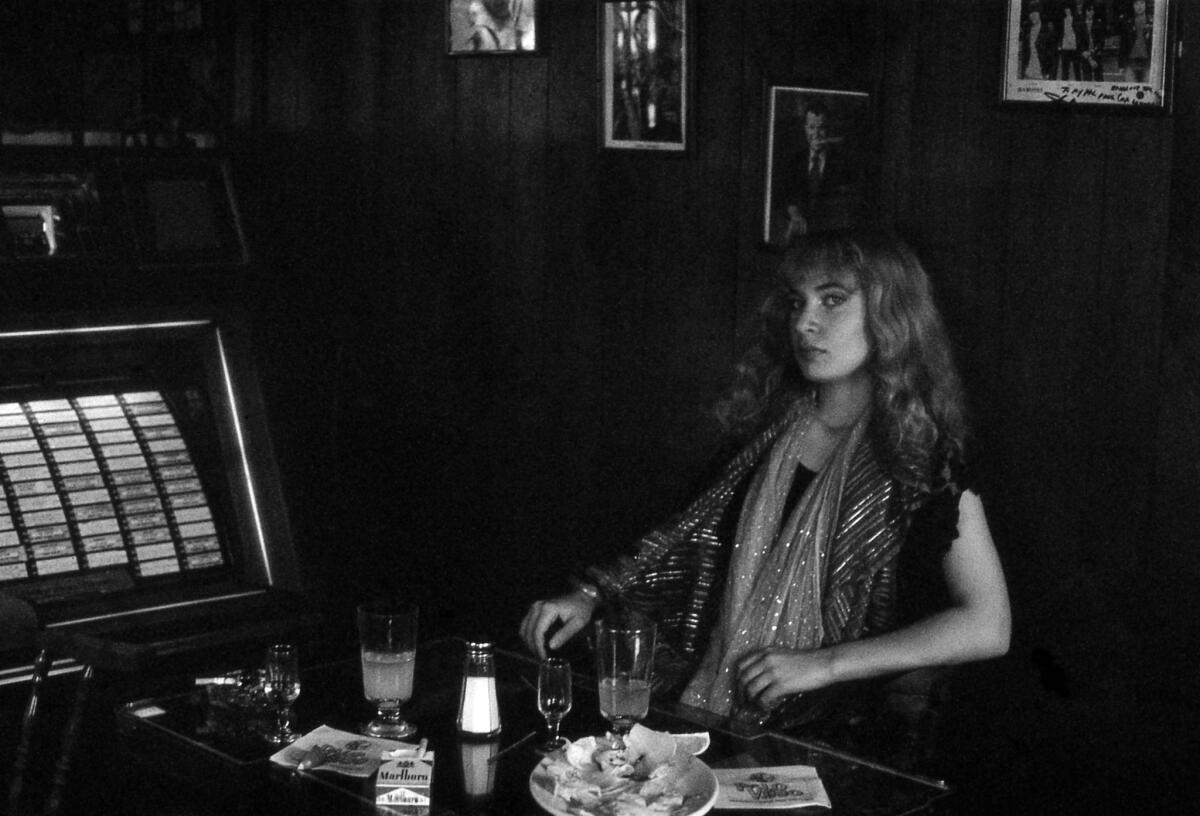
Geta Brătescu, “The Leaps of Aesop,” at Hauser & Wirth. The 92-year-old Romanian conceptualist’s first show in Los Angeles consists of more than 50 works drawn from throughout different periods of her career — all inspired by the Greek fabulist Aesop. The artist regards Aesop as a mischievous figure, a symbol of “everything that stood against totalitarianism,” and one who parallels the subversive characters in Romanian folk tales. In her own work, she uses play and other inventive approaches to material to convey these and other ideas. Through May 20. 901 E. 3rd St., downtown Los Angeles, hauserwirthlosangeles.com.
Mark Bradford, “New Works,” at Hauser & Wirth. The gallery is showing a suite of new works by the Los Angeles painter, who continues his process of creating abstraction through collaging, tearing, painting and layering. The new works, which employ comic books in their fabrication, pack a visceral punch. Through May 20. 901 E. 3rd St., downtown Los Angeles. hauserwirthlosangeles.com.
“It Passes Like a Thought,” at the Beall Center for Art + Technology. Seven contemporary artists engage with the human obsession with birds — species studied by armies of ornithologists, linguists and musicologists, and devotedly followed by equally large armies of birders. Artists such as Victoria Vesna and Susan Silton explore birdsong, while Lynn Aldrich and Juan Fontanive look at flight. Other installations mechanize bird movement. Through May 26. 712 Arts Plaza, UC Irvine, Irvine, beallcenter.uci.edu.
“March of Eyes,” at Cirrus Gallery. Centered around a new series of Cirrus prints by L.A. artist Math Bass, the show also gathers pieces by five emerging artists who address issues such as perspective and viewership in their work. Through May 26. 2011 S. Santa Fe Ave., Los Angeles, cirrusgallery.com.
“Inhabit: the Olmsted Brothers at Palos Verdes Peninsula,” at the Palos Verdes Art Center. In the early 20th century, a consortium of businessmen that invested in land on the Palos Verdes Peninsula invited the Olmsted Brothers landscape architecture firm (their father designed Central Park), to create a Mediterranean oasis there. The brothers began their project by undertaking a profound study of the area. This exhibition gathers many of their materials: drawings, topographic maps, studies of flora and fauna. A historic look at the Los Angeles of a century ago. Through May 27. 5504 W. Crestridge Road, Rancho Palos Verdes, pvartcenter.org.
“Paper Promises: Early American Photography,” at the Getty Museum. As the United States expanded throughout the 19th century, and news of the Civil War racked the nation, there was a growing demand for images that were easy to reproduce and distribute — hence the turn from daguerreotypes to paper photography. This exhibition looks at some of the earliest examples of the medium, an important period of experimentation that included mournful battlefield imagery and regal portraiture, including notable images of Abraham Lincoln. Through May 27. 1200 Getty Center Drive, Brentwood, Los Angeles, getty.edu.
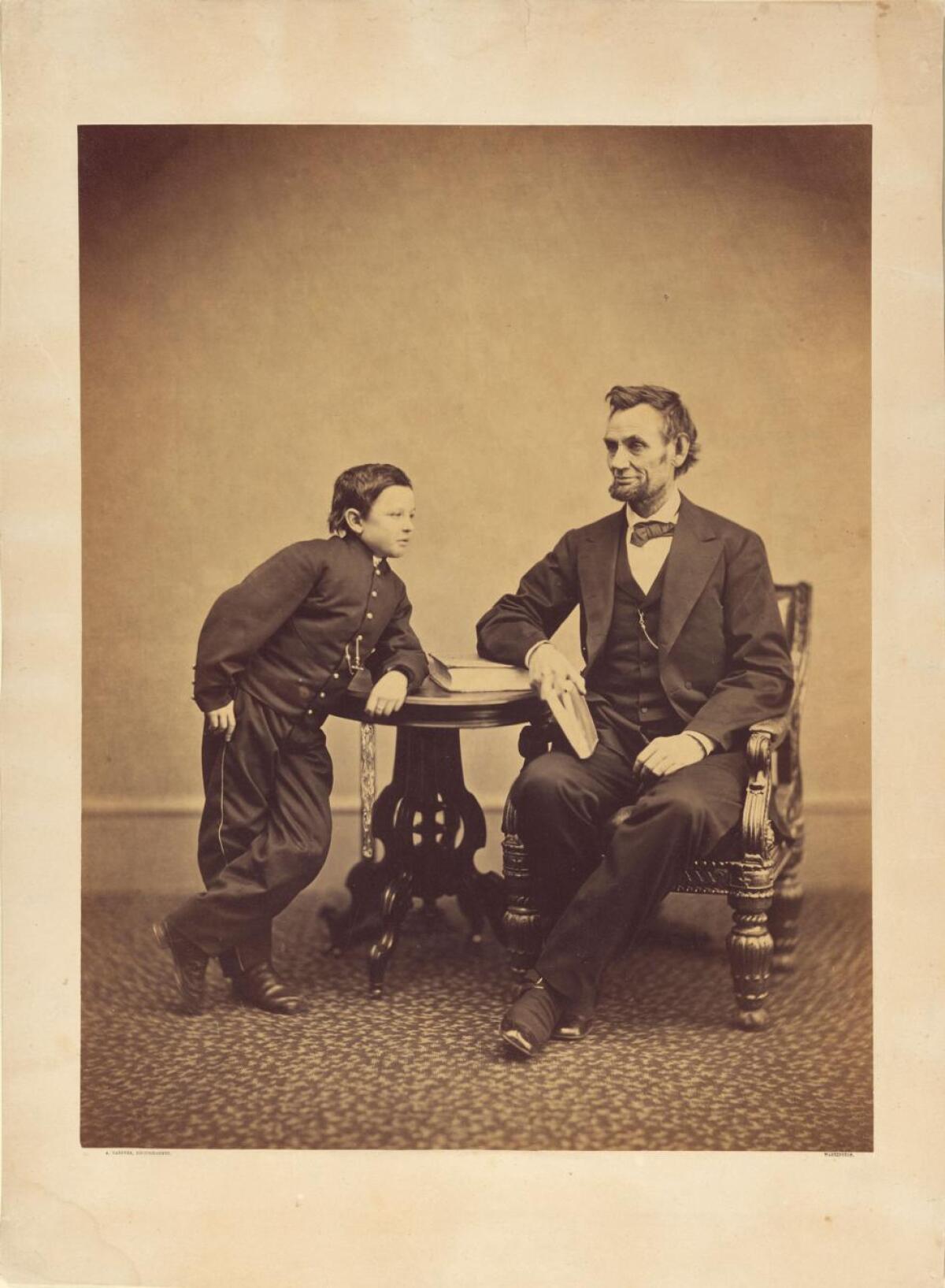
“Cut! Paper Play in Contemporary Photography,” at the Getty Museum. Another photography-related exhibition at the Getty looks at the medium’s intersection with cut paper. This includes cut-paper models that are then photographed, and photographic images that are collaged into three-dimensional pieces. Through May 27. 1200 Getty Center Drive, Brentwood, Los Angeles, getty.edu.
“Tony DeLap: A Retrospective,” at the Laguna Art Museum. The museum has put together a retrospective dedicated to the Southern California finish/fetish artist who has explored color, form and minimalism in a career that has spanned more than six decades. The show will feature an estimated 80 paintings, sculptures and drawings — and an accompanying catalog will track the arc of his career. Through May 28, 307 Cliff Drive, Laguna Beach, lagunaartmuseum.org.
“Testament of the Spirit: Paintings by Eduardo Carrillo,” at the Pasadena Museum of California Art. A solo exhibition devoted to the Los Angeles painter and educator examines his legacy and work. The show includes the exhibition of a celebrated mural, “Chicano History,” that Carrillo painted with Sergio Hernandez, Ramses Noriega and Saul Solache, and which is on view for the first time since 1991. The museum has also unveiled two other exhibitions: “The Feminine Sublime,” a group show that takes ideas of the sublime, generally depicted from a male point of view, and gives it a decidedly feminine twist, as well as an installation by Ana Serrano, who is creating an immersive “garden” out of simple art materials such as cardboard, paper and paint. Through June 3. 490 E. Union St., Pasadena, pmcaonline.org.
“In Conversation: Alma Allen & J.B. Blunk,” at the Palm Springs Art Museum. This exhibition puts together the work of two key artists from two generations working with natural materials such as stone, wood and metal. J.B. Blunk, who died in 2002, began making work in the ’60s inspired by organic and anthropomorphic forms. Allen, a contemporary artist, quite similarly works in metal and wood and is inspired by nature’s shapes and textures. Both have created functional objects (such as elements of their homes) as well as sculptures that are experimental and abstract. Through June 4. 300 S. Palm Canyon Drive, Palm Springs, psmuseum.org.
“Winds From Fusang: Mexico and China in the Twentieth Century,” at the USC Pacific Asia Museum. This is the first major exhibition to look at a key trans-Pacific cross-pollination: the influence of Mexican art on the development of art in China in the 20th century. This includes an examination of the period in the 1930s that Mexican artist Miguel Covarrubias spent in Shanghai, and a look at a subsequent era, from the 1950s to the ’70s, when works by key Mexican artists were presented in China. The show, part of PST: LA/LA, is a grand reopening for the museum following a seismic retrofit. Through June 10. 46 N. Los Robles Ave., Pasadena, pacificasiamuseum.usc.edu.
Gilbert “Magu” Luján, “Recuerdos del Futuro: Roaming Magu’s Chicano Dreams,” at La Plaza de Cultura y Artes. This show on the late artist, a founding member of the influential collective Los Four, gathers 81 works — including paintings, drawings and sculpture — that tracks the ways in which he employed quotidian imagery to channel a Chicano futurist vibe. Embedded in his paintings and surreal installations were images of graffiti, lowriders, dogs and elements of the rasquache (or lowbrow). As part of the show, two contemporary artists — calligraphy artist JERK and printmaker Daniel Gonzalez — created work in dialogue with Magu. Through June 25. 501 N. Main St., downtown Los Angeles, lapca.org.
Meleko Mokgosi, “Bread, Butter, and Power,” at the Fowler Museum. Mokgosi first drew wide attention in Los Angeles when he won the $100,000 inaugural Mohn Prize at the Hammer Museum’s “Made in L.A.” biennial in 2012. Now he’s back with a large-scale painting exhibition at the Fowler — a 20-panel installation that looks at how democratic concepts infuse aspects of daily life, down to love and relationships. Through July 1. 308 Charles E. Young Drive North, Westwood, Los Angeles, fowler.ucla.edu.
“Soul Mining,” at the Vincent Price Art Museum. A new group show examines the influence Asian immigrants have had on the economics and the culture of Latin America. Some of this connects with the anti-immigration histories of the U.S.: when the Chinese Exclusion Act was signed into law in 1882, Chinese laborers expelled from the U.S. moved on to Latin America, having a profound effect on the continent’s social, political and cultural landscapes. Also on view are works from the L.A. County Museum of Art’s permanent collection: the Mexico photographs of Mariana Yampolsky and objects from the museum’s holdings of ancient Egyptian art. Through July 14. East Los Angeles College, 1301 Cesar Chavez Ave., Monterey Park, vincentpriceartmuseum.org.
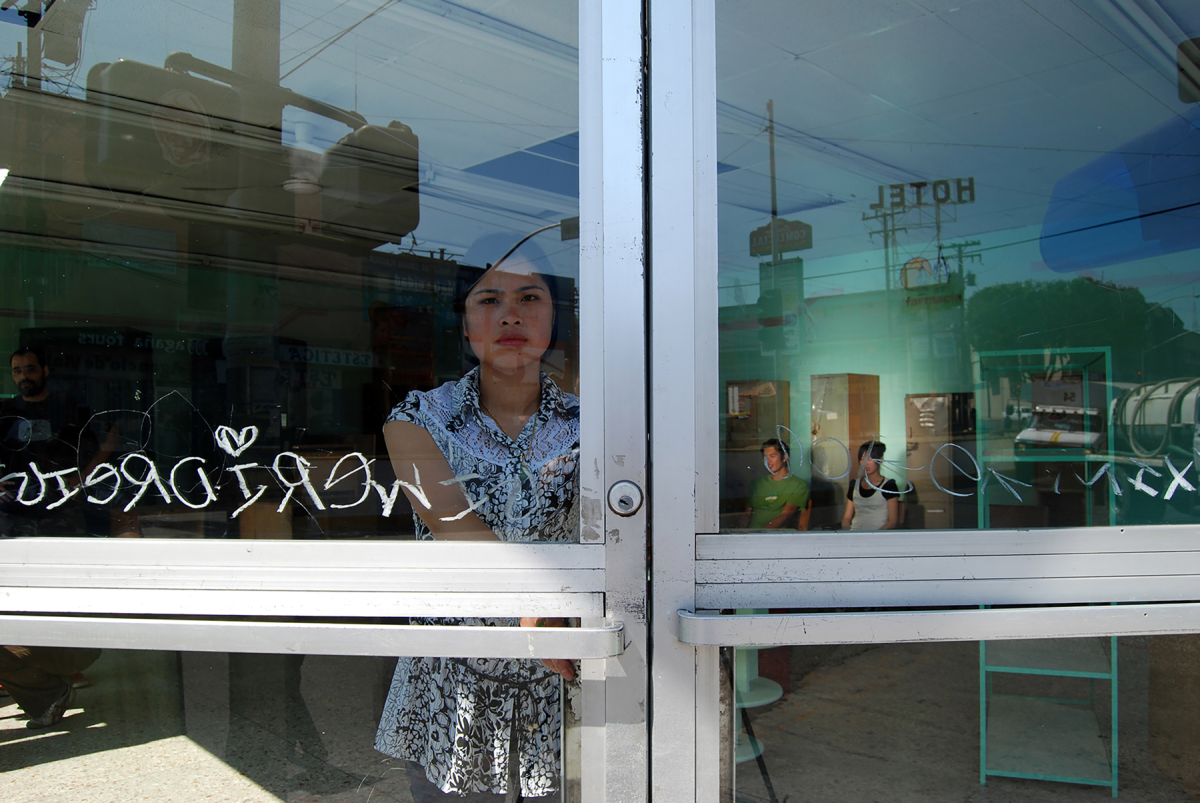
Leopoldo Peña, “Pelotas Oaxaqueñas/Oaxacan Ball Games,” at the Fowler Museum. For five years beginning in 2011, the L.A.-based painter documented the traditional games played by California’s Oaxacan immigrant community. The games includes the centuries-old pelota mixteca (Mixtec-style ball) and variant called pelota de esponja (sponge ball), both played with decorated mitts that combine indigenous design with contemporary logos. The games, which often take place in empty lots around the San Fernando Valley, are fast-paced affairs that serve as important social gatherings. Through July 15. 308 Charles E. Young Drive North, Westwood, Los Angeles, fowler.ucla.edu.
“City and Cosmos: The Arts of Teotihuacan,” at the Los Angeles County Museum of Art. In its day, the ancient city of Teotihuacan was the largest urban center in the Americas — and the sixth-largest city in the world. Today, it is an iconic Mexican archaeological site. This exhibition presents recent findings from excavations at the site’s three main pyramids. It includes more than 200 objects that help tell the story of the ancient city, including monumental sculpture and smaller-scale objects that include precious stones. Through July 15. 5905 Wilshire Blvd., Mid-Wilshire, Los Angeles, lacma.org.
“Extracorporeal,” at the Museum of Latin American Art. Inspired by the art of the late Cuban American artist Ana Mendieta, whose actions and photographs explored violence, place and the body, “Extracorporeal” gathers works by four U.S. and Latin American artists whose work also operates in that vein. This will include sculpture, video and performance by Antonio Paucar, Daniela Rojas, Roberto Tondopó and the L.A.-based Carmen Argote. Through July 29. 628 Alamitos Ave., Long Beach, molaa.org.

“Gary Simmons: Fade to Black,” at the California African American Museum. In a lobby installation — one that takes full advantage of its size and scale — Simmons pays tribute to forgotten African American actors and films. On a black background, the L.A. artist features the titles and names of films and individuals important to the early days of Hollywood history, but forgotten over time. Through July 2018. 600 State Drive, Exposition Park, Los Angeles, caamuseum.org.
Harry Gamboa Jr., “Chicano Male Unbonded,” at the Autry Museum of the American West. For years, Gamboa has photographed Chicano men — often figures with whom he has a personal relationship — at night in the dark from a low angle, giving his figures an imposing authority. This exhibition gathers more than 80 of those images into a single-room installation: scholars, artists, musicians, thinkers, photographers and even the artist’s dad, a printer — collectively calling into question the general public’s (not to mention our president’s) stereotyped view of Mexican American men. Through Aug. 5. 4700 Western Heritage Way, Griffith Park, Los Angeles, theautry.org.
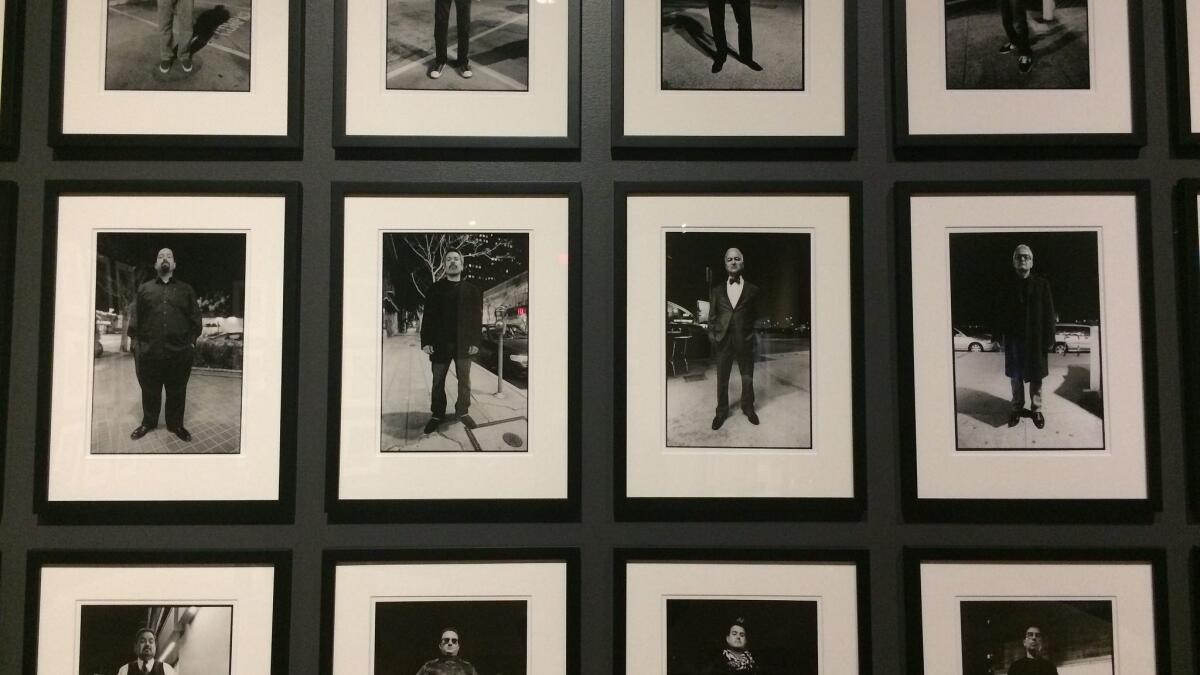
Adler Guerrier, “Conditions and Forms for blck Longevity,” at California African American Museum. The Haitian artist is the subject of a solo exhibition at the museum that explores the nature of domestic gardens and other outdoor spaces as mini-utopias. This project looks at spaces in Miami and L.A. where black life takes place in sheltered, protected ways. Through Aug. 26. 600 State Drive, Exposition Park, Los Angeles, caamuseum.org.
Olafur Eliasson, “Reality Projector,” at the Marciano Art Foundation. Eliasson has created an environmental installation for the foundation’s first floor Theater Gallery that combines sculpture, painting, photography and film. The piece works with the former Masonic Temple’s existing architecture to create a play on forms and shadows. It’s an installation that Times art critic Christopher Knight describes as “eye-grabbingly vivid.” Through August. 4357 Wilshire Blvd., Windsor Square, Los Angeles, marcianoartfoundation.org.
Lauren Halsey, “we still here, there” at the Museum of Contemporary Art. The artist has taken up residence at the museum’s Grand Avenue location, where she is building a fantastical immersive environment that will evolve over time. Through Sept. 3. MOCA Grand Avenue, 250 S. Grand Ave., downtown Los Angeles, moca.org.
Shinique Smith, “Refuge,” at California African American Museum. The multimedia artist is known for her bulbous assemblages crafted from old clothing and fabric, which she twists and ties and suspends from gallery ceilings and walls. Her paintings echo these bound and squeezed forms. Her first solo show at CAAM brings together works that evoke questions of homelessness and itinerancy. Through Sept. 9. 600 State Drive, Exposition Park, Los Angeles, caamuseum.org.
“Charting the Terrain: Eric Mack and Pamela Smith Hudson” at the California African American Museum. A pair of artists explore aspects of Western landscape through abstraction. In his work, Mack creates intricate compositions that echo aspects of movement and the urban grid, while Hudson’s works evoke the topographic — mapping devastation and rejuvenation. Through Sept. 9. 600 State Drive, Exposition Park, Los Angeles, caamuseum.org.
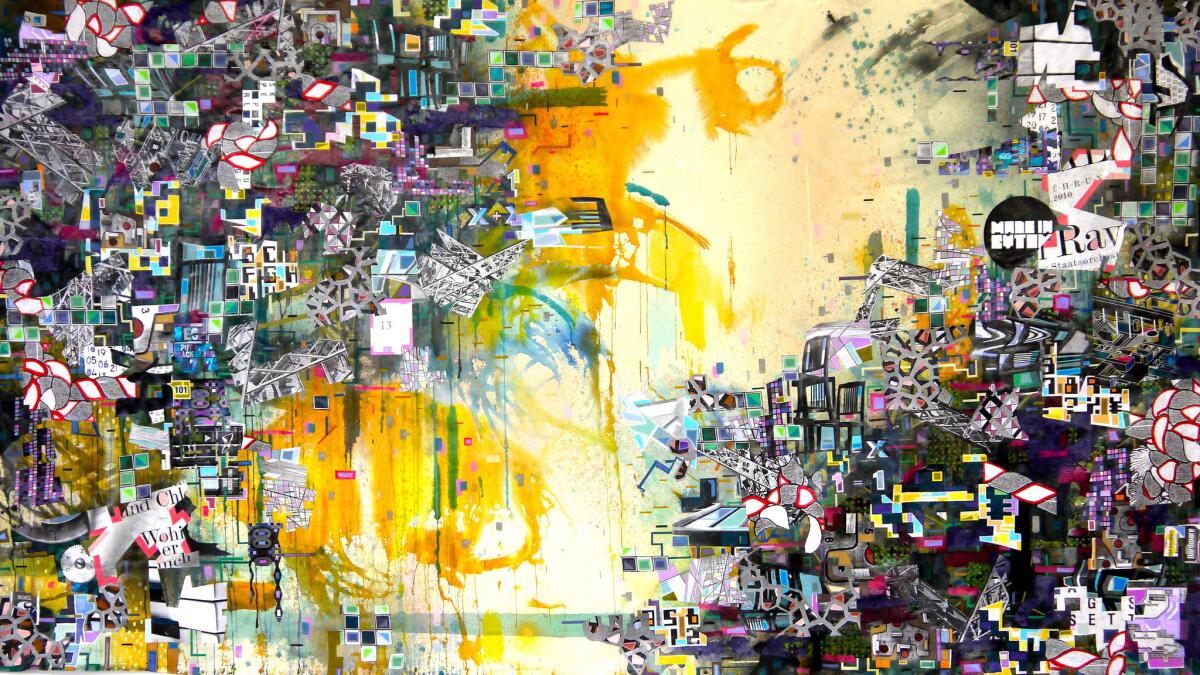
“The Archival Impulse: 40 Years at LACE,” at Los Angeles Contemporary Exhibitions. LACE, the historic Los Angeles art spot that gave key shows to Mike Kelley and groups such as Survival Research Laboratories in the ’80s, is turning 40 — and to mark the occasion, the organization has been poking around its metaphorical attic (aka its archive) to see what it might turn up. This show gathers elements from that archive as well as video works by a range of Los Angeles artists, including Jim Shaw, Susan Mogul and Reza Abdoh. Through December. 6522 Hollywood Blvd., Hollywood, welcometolace.org.
“La Raza,” at the Autry Museum of the American West. In its day, the civil rights publication La Raza, which was based in Lincoln Heights, served as a bible for the Chicano movement, covering protest, policy and everyday life for the Mexican American communities of Los Angeles. Over the years, the paper amassed an archive of 25,000 images, recently digitized by the Chicano Studies Research Center. Many are now on view as part of this PST: LA/LA show at the Autry — and in a time of political strife surrounding the issues of civil rights, this exhibition couldn’t be more timely. Through Feb. 10, 2019. 4700 Western Heritage Way, Griffith Park, Los Angeles, theautry.org.
“Artists of Color,” at the Underground Museum. As part of its ongoing partnership with the Museum of Contemporary Art, the Arlington Heights arts space has put together an exhibition that focuses on color — on its aesthetics, as well as the roles color can play as a symbol, affecting the way it’s perceived both socially and politically. The show includes works by an array of artists, including Ellsworth Kelly, Dan Flavin, Lita Albuquerque, EJ Hill, Felix Gonzalez-Torres, Josef Albers, Carmen Herrera and Noah Davis (the late founder of the Underground Museum). It’s a striking look at color seen anew. On long-term view; no closing date set. 3508 W. Washington Blvd., Arlington Heights, theunderground-museum.org.
“L.A. Communities Through the Eyes of Artists,” in the Passageway Gallery at Union Station. For 15 years, L.A.’s principal train station has been showcasing work that reveals the city through the eyes of its artists. This year, it is showing a series of newly commissioned pieces — including Shizu Saldamando’s depiction of Little Tokyo, Sam Pace on Leimert Park and Artemio Rodriguez on East L.A. On long-term view; no closing date set. Union Station, 800 N. Alameda St., downtown Los Angeles, metro.net.
Alejandro G. Iñárritu, “Carne y Arena,” at LACMA. The gripping new virtual reality experience by the Academy Award-winning director places the participant in the shoes of migrants making the arduous trek through the Sonoran Desert to reach the United States. This may sound like the trivialization of what can be a fatal journey, but it is not. Iñárritu has considered all the elements that surround his virtual reality video to humanize the story of immigration on the U.S.-Mexico border. I wrote about my experience of the piece in June. It’s not cheap (a $30 special admission, in addition to regular museum fees) but it’s worth every penny. On long-term view; no closing date set. 5905 Wilshire Blvd., mid-Wilshire, Los Angeles, lacma.org.
Daniel Hawkins, “Desert Lighthouse.” The Los Angeles-based artist is obsessed with producing works that toy with ideas of grandiosity, failure and gestures that border on the Sisyphean. (One of his goals as an artist is to ultimately build a scale replica of the Hoover Dam.) Now Hawkins has installed a 50-foot tall, fully functioning lighthouse in the Mojave Desert in the vicinity of Barstow. The piece even features a light to guide travelers through this rugged landscape. Directions and coordinates can be found on the website. On long-term view, Hinkley, Calif., desertlighthouse.org.
Sign up for our weekly Essential Arts & Culture newsletter »
Twitter: @cmonstah
The biggest entertainment stories
Get our big stories about Hollywood, film, television, music, arts, culture and more right in your inbox as soon as they publish.
You may occasionally receive promotional content from the Los Angeles Times.








